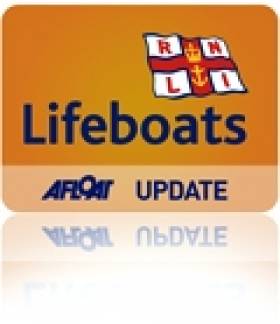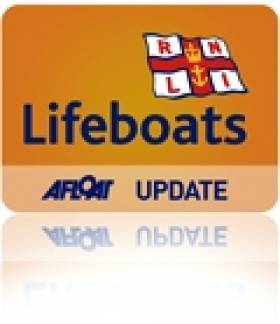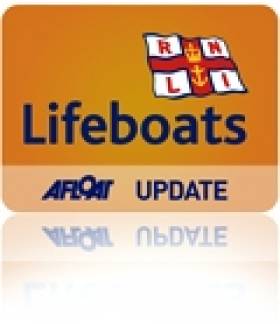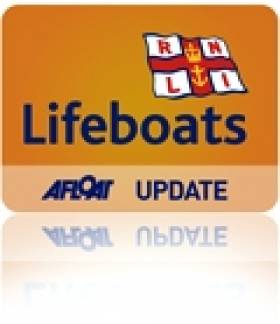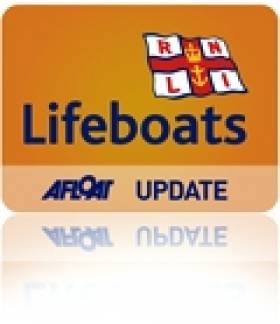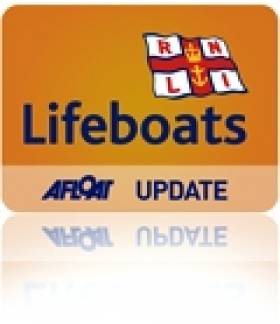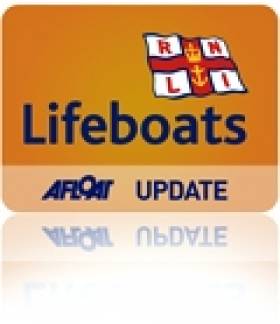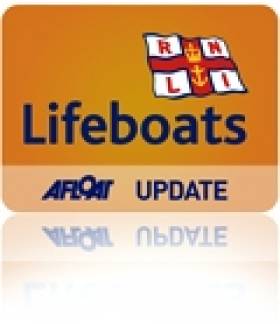Displaying items by tag: Lifeboats
Larne Lifeboats In Two Separate Call-Outs
#RNLI - Larne RNLI was called out for assistance on two separate occasions this past week.
On Thursday night 6 June, the volunteer lifeboat Dr John McSparran responded to a request by Belfast Coastguard to assist a lone yachtsman who had become disorientated in sea fog.
Weather conditions at the time were described as flat calm with no wind at all. However, a sea fog had come down in the evening, and the man on board - having left Girvan in Scotland en route to Glenarm Marina in an old gaffer to celebrate the Old Gaffers Association's Golden Jubilee - got into difficulty.
The casualty was located becalmed seven miles east of The Maidens Lighthouse. Lifeboat crew members Martin Agnew and Scott Leitch were put on board to assist after it was discovered that the casualty's outboard engine had failed and the gaffer was making no headway against the tide.
It was decided by Coxswain Frank Healy to tow the casualty to Glenarm, keeping the two crew members on board to assist. The vessels and crews arrived in Glenarm at 1.30am.
Two nights before, Larne RNLI assisted two men after their motor boat got into difficulty on Belfast Lough.
The volunteer crew launched their inshore lifeboat, the Hannahbella Ferguson, at 8.15pm following a request to assist the speed boat which had sustained engine failure off Muck Island.
Two men, both wearing lifejackets, were on board. Weather conditions at the time were described as good with a flat calm sea.
The casualty boat was subsequently towed safely to shore by the lifeboat to Portmuck Harbour.
Crew on this call out included helm Willie Evans, Martin Agnew and Jay Torbitt.
RNLI Lifeboats Have Busy June Bank Holiday Weekend
#RNLI - It was a busy June bank holiday weekend around the country for RNLI lifeboats in West Cork, Mayo and the Midlands.
On Sunday afternoon, Baltimore RNLI assisted four people after their yacht got into difficulty a mile south of Mizen Head.
The 32ft yacht with four people on board had been propped by a pot buoy immobilising her in the water. The alarm was raised at 10.41am and lifeboat the Alan Massey was launched minutes later.
A local RIB, which had commenced towing, passed the tow to the lifeboat and the yacht was then taken to the safety of Crookhaven Pier.
This was the second call out this week for Baltimore RNLI. On Thursday last three men were rescued when their punt overturned near Horse Island.
Later on Sunday, Achill Island RNLI in Co Mayo brought a distressed fishing vessel with seven people on board to safety.
The volunteer lifeboat crew was requested to launch at 4.50pm to assist a small fishing vessel in the vicinity of Clew Bay and close to Clare Island. The vessel had encountered engine problems and was unable to return to port.
The boat and its crew of seven were subsequently towed safely to Curraun harbour by the Achill Island RNLI lifeboat.
Speaking after, Achill Island RNLI lifeboat operations manager Tom Honeyman said: "The presence of thick fog surrounding the vessel meant that great care was needed in the rescue and the fishing party of the vessel were delighted to return empty handed for a change."
Meanwhile in the Midlands, Lough Ree RNLI brought five people to safety in two call-outs over the weekend.
On Friday 31 May the volunteer crew was requested to launch around 5pm following a report that a cruiser had ran aground north of Quaker Island.
A local fisherman raised the alarm after spotting the cruiser on the rocks at the island located in the north end of Lough Ree raised the alarm.
The lifeboat crew managed to establish contact with the person on board the cruiser via mobile phone and he had confirmed that he had got lost and had ran aground. He reported that there was no water entering his boat. He was on his own but not injured.
The inshore lifeboat was launched and the crew was on scene at 5.30pm. It took the lifeboat 10 minutes to safely navigate its way through the rocky area to reach the casualty. The person on board the cruiser was taken to shore and arrangements were made for a specialist company to attend the scene to recover the cruiser.
Lough Ree RNLI was then launched on Sunday evening to assist a 26ft cruiser which had ran aground east of Green Island after sustaining engine failure.
The small cruiser with a family of four on board had lost engine power and had ran aground on the south east side of Lough Ree.
A crew launched the lifeboat at 8.40pm and arrived on scene 10 minutes later. After one of the lifeboat crew had carried out an assessment of the causality vessel, the decision was made to make an attempt to pull the vessel from the rocks, which the lifeboat was successfully able to complete.
Once the lifeboat had the vessel in deep water, a tow was set up and the casualty vessel was taken to Quigleys Marina in Athlone.
It marked the continuation of a dramatic week for the Lough Ree crew, after six were rescued from a sinking cruiser on the lough last Tuesday 28 May.
#RNLI - Kilrush RNLI in Co Clare was diverted from exercise training on Tuesday 28 May when the lifeboat came to the assistance of a 10ft boat.
The volunteer lifeboat crew at Kilrush were returning from their weekly training exercise at 8.45pm when they were requested to go in search of a vessel that had lost its moorings at Tarbert pier.
After relaying the situation to the Coast Guard at Valentia and getting permission to launch, the inshore lifeboat Edith Louise Eastwick set off to the Tarbert area and carried out an extensive search. Weather conditions at the time were blowing force three to four northerly winds.
The crew continued eastwards and crossed over to the Labasheeda region where they located the 10ft punt off Kilkerrin Point.
After securing the vessel to the lifeboat, the crew brought it back to Tarbert pier where the owners were waiting. The vessel was handed over and a request that a new mooring line be put in place was made.
The call out was crew member Charlie Glynn’s first as helm, having secured the position a month ago.
Earlier that day, Enniskillen RNLI was launched to reports of a cruiser which had run aground on Lower Lough Erne in Co Fermanagh.
The volunteer crew on their inshore lifeboat Joseph and Mary Hiley and the Rescue Water Craft (RWC) proceeded to Inish Davar, two miles from the station. Weather at the time was clear with calm waters.
The crew arrived at the location to find the owner of the vessel on another boat and assisting the casualty boat and the two men and two women who were on board and safe and well. The lifeboat crew stood off and observed from a distance.
New Lifeboat Station For Upper Lough Erne
#RNLI - Enniskillen RNLI is to get a new lifeboat station at its Carrybridge base on Upper Lough Erne, it has emerged.
Planning permission for the new build has been passed by Fermanagh District Council and the RNLI’s tendering process is now underway, with a view for building work to commence in late summer.
Once complete, the modern station - much like the new facility for Castletownbere RNLI that opened recently - will replace the existing temporary accommodation which has housed the charity’s volunteer lifeboat crew for the past 11 years.
In order to facilitate the project, the local community is being asked to help the RNLI raise £60,000 (€70,000) towards the cost, which will help Enniskillen RNLI continue to save lives on Lough Erne.
In 2001, Enniskillen became home to the RNLI’s first inland lifeboat station based on Lower Lough Erne.
Due to the overall size and complexity of the lough and its high leisure usage, the decision was taken by the RNLI in 2002 to base a second lifeboat on the upper lough that would work in conjunction with the original lifeboat station on the lower lough.
With two bases, two inshore lifeboats and two rescue water craft, the station has since proved to be one of the busiest in Ireland.
Last year alone, Enniskillen RNLI launched 46 times bringing 50 people to safety. Some 20 of those services were carried out in the dark while the crew spent 169 service hours on the water.
RNLI divisional operations manager Gareth Morrison said he was delighted that planning had now been approved making way for what will be a purpose-built station in a location close to the lough allowing for an efficient launch.
"In an area that receives over 100 days of heavy rainfall a year, it is hard to believe the volunteer crew based at the upper lough operate from just a temporary facility, partly exposed to the elements," said Morrison.
"The crew has to change in a small, damp, metal container and only has a portaloo and wash basin for their comfort. There is nowhere for the crew to shower or dry after a challenging rescue and nowhere for them to gather and train together during the week.
"We want to build a modern station with full crew facilities with areas for the crew to change and train and space to keep their lifeboat and rescue water craft and lifesaving kit safe."
Enniskillen RNLI lifeboat operations manager Davey Robinson said a new station was what the crew deserved.
"At the moment we are operating out of a temporary facility. It is cramped and there are no showers so the crew cannot warm up after a cold, wet and tiring rescue. A new station will be great for the crew. We are a busy station so it is what they deserve."
He added: "It is always reassuring for locals and visitors alike that the RNLI is here to assist them or help their loved ones when they get into difficulty. We try to act as a safety net on Lough Erne and are here 24 hours a day. But we need the right facilities to do that and this new station will help."
Donations and other assistance with fundraising are welcome. For details contact Tony Hiney, RNLI community fundraising manager, at 087 219 8917 or email [email protected].
#RNLI - The volunteer lifeboat crew at Kilmore Quay RNLI in Co Wexford had a busy time last week with five call-outs in seven days.
In the first incident on Monday 13 May, a French 6.5m yacht with two people on board got into difficulty as it was taking part in a 'mini Fastnet' yacht race.
The vessel’s crew decided to make for Kilmore Quay due to adverse weather. The yacht had no engine due to race rules and so the lifeboat was reqested to help the crew safely get into the harbour.
The second call-out came last Wednesday evening (15 May) when a member of the public reported to Dublin Coast Guard that a yacht was close in shore and flashing a light.
As the lifeboat crew were letting go the ropes, the coastguard made contact with the vessel, which was at anchor and did not require any assistance.
On Friday afternoon 17 May, the volunteer crew was alerted when an 8m pleasure craft with two people on board had fouled its propeller a quarter mile off the South Head of the Great Saltee Island.
The vessel was freed by the lifeboat crew using a grapnel hook and cutting the rope before towing the boat back to Kilmore Quay Marina.
And last Sunday 19 May saw two shouts which were similar in nature.
The first in the morning involved a small leisure craft with four people on board which suffered engine failure. The crew was relying on a mobile phone for their communications and combined with poor English, it made the task of finding them more challenging.
The crew members were eventually located to the west of the Saltees and were brought back ashore safe and well.
Later the same day, another small leisure craft - this time with three people aboard and again relying on a mobile phone for their communications - had lost power while fishing at the south side of the Little Saltee Island.
The lifeboat was on scene a short time later and towed the vessel back to Kilmore Quay.
Stranded Students Rescued From Island By Galway RNLI
#RNLI - Galway RNLI came to the rescue of three students who got stranded on Hare Island yesterday afternoon (Monday 13 May) after getting caught in the tide off Ballyloughane Beach.
The two young women and young man, in their late teens/early 20s, had gone for a walk and were spotted waving from the island by a local resident who contacted the emergency services and Galway RNLI.
Conditions at the time (around 4pm) were changeable with heavy showers.
Three volunteer members of the inshore lifeboat crew were working in the vicinity of the station at the time and launched the boat in six minutes.
The three students were picked up safely and brought back to the lifeboat station at Galway Docks where they were warmed up and given tea. They did not require medical attention.
The lifeboat crew on this callout were helm David Oliver, Dara Oliver, David Badger and Olivia Byrne.
Lifeboat shore crew John Bryne said: "The three students did the right thing waiting on the island and not attempting to get off."
It's not the first time that people have been stranded by the incoming tide on Hare Island, as Galway RNLI were called to a similar incident in September 2010.
#RNLI - Dun Laoghaire RNLI was involved in the recovery yesterday afternoon of a sinking boat following the rescue of three people after the vessel began to sink off the Wicklow coast.
Three people were pulled from the water when their small boat got into difficulty off Bray on Sunday 12 May.
A local boat responded to the Mayday alert and brought the casualties to safety.
The RNLI lifeboat from Dun Laoghaire and the Greystones Coast Guard boat took the boat that was almost fully submersed under tow to shore.
Winds gusted to storm force towards the end of the operation but conditions were otherwise fresh, with only choppy waves off the coast.
The incident occurred shortly after midday when the 15ft speedboat was almost one mile from Bray Harbour.
Koda The Husky Rescued By Quick-Thinking RNLI Crew
#RNLI - Two volunteer crew members from Kinsale RNLI came to the rescue of a husky dog who had a dramatic fall off a cliff near the Co Cork village recently.
Koda, a pedigree husky, was inspecting the coastline around Sandycove when she got too close to the edge and slipped over the 30ft cliff.
The dog landed in water with a strong current that swept her out to sea despite her desperate struggles to reach the shore. She managed to get herself back on a ledge by which time the alarm was raised and volunteer lifeboat crew were on their way.
A jagged reef also meant that Kinsale RNLI’s inshore lifeboat couldn't get close enough to help drag the struggling dog from the water.
However, Kinsale RNLI volunteers Nick Searls and Ian Fitzgerald were at the scene within minutes, and realised the danger facing the terrified dog.
Searles dived into the sea and swam over 60 metres to reach the animal. He managed to attach a harness and was able to swim slowly back to shore, dragging the weakened Koda with him. He was then assisted by safety line out of the sea by Fitzgerald.
Koda was immediately taken to a Kinsale vet, who confirmed that despite being exhausted and shocked by her ordeal, the dog was none the worse for wear.
In other news, Donaghadee RNLI assisted two men on board a yacht which got into difficulty off the Co Down coast yesterday morning (Tuesday 7 May).
The volunteer lifeboat crew was requested to launch at 9.50am by Bangor Coastguard to go to the aid of a yacht which had ran aground.
The 30ft yacht with two people on board had gone aground on rocks at the entrance to Donaghadee Marina.
With the help of another vessel, the lifeboat crew was quickly able to get a tow line to the yacht and pull it off the rocks.
The yacht, which had sustained some damage to its rudder, was able to make its way safely into the marina.
#RNLI - Portaferry RNLI is looking for new volunteer crew members to join its search and rescue service in Co Down.
The station currently has 17 lifeboat and two shore crew to cover its inshore service on Strangford Lough but is now calling on new volunteers to come forward and find out how they can get involved in helping the charity continue to save lives at sea.
To that end, the station will be hosting two open days early next month for all interested candidates to learn more.
"We are looking for anyone aged 17 years and over who is willing to offer some of their free time to join what I believe to be, one of the most exhilarating and rewarding voluntary services that is out there," said lifeboat operations manager Brian Bailie.
"Every volunteer receives first class training from the RNLI and learns new skills which can benefit them in many walks of life. Lifeboat crew members need to have a reasonable level of fitness, have good eyesight and not be colour-blind."
He added: "Anyone who would like to volunteer but feels they would not meet the requirements for lifeboat crew should in no way be put off, as shore crew also play an essential role in the launch and recovery of the lifeboat when it goes on service."
For anyone who feels they have the time and commitment to volunteer for the charity which is on call 24 hours a day, 365 days a year, is asked to email Brian at [email protected].
Alternatively, prospective volunteers can come along to the station’s open days from 7-9pm next Tuesday 7 May or from 2-4pm next Saturday 11 May.
Elsewhere in Northern Ireland, primary school children will have the opportunity to hit the surf with RNLI lifeguards over the next month.
The charity’s ‘Hit the Surf’ programme runs from 7 May to 7 June on the East Strand Beach in Portrush.
Aimed at primary five to seven pupils aged eight to 11, the programme - which is expanding to accommodate more schools this year - gives children a unique opportunity to gain practical lessons in lifesaving and beach safety. All equipment is provided free of charge.
Each session lasts two-and-a half-hours and includes a theory lesson on staying safe at the beach, the role of beach lifeguards and the RNLI, and detailed information on flags and rip currents.
There are practical lessons in lifesaving and surf based skills, while lifeguards aim to build pupils confidence in the sea. Children also learn about the local hazards and the beach environment.
Sessions are still available for schools who want to book pupils in. For more information contact Jessica on 0777 441 4208 or email [email protected]
Last year RNLI lifeguards located on beaches in Co Down and along the Causeway Coast responded to 158 incidents and assisted 176 people who found themselves in difficulty.
#RNLI - Kilrush RNLI lifeboat station was put on standby on Monday 29 April for an aircraft with engine trouble, and later called to a person who drove into the water.
At 2pm on Monday the Irish Coast Guard at Shannon alerted the station authorities that there was a private aircraft descending in the region of the River Shannon with engine problems. It was reported that there were four people on board.
After a half an hour the lifeboat crew were informed the plane made a safe landing at Shannon Airport and the station was stood down.
Later that day at 8.47pm pagers were activated by the coastguard in Shannon to alert the crew that a person was reported to have driven off the road into the water in the area of Labasheeda, about nine nautical miles from Kilrush.
The lifeboat crew assembled and within eight minutes were launched and on their way to this area. Conditions on this evening were most favourable.
After five minutes they were stood down as members of the local Gardai had managed to rescue the driver and bring him ashore. An ambulance was standing by at this area to assist the casualty and team of helpers.
Kilrush lifeboat operations manager John Lamb praised the speed of the crew and the efficiency on which the launch took place.
“At times like these it’s always good to know that our team are trained to the highest standards to deal with callouts such as this evening,” he said.
In other news, President Michael D Higgins will pay a special call to Courtmacsherry RNLI lifeboat station this weekend during an official visit to the Cork village.
While there he will view an impressive historical exhibition which is running all through the May bank holiday weekend.
The exhibition, which has been planned for months, will have a strong emphasis on the lifeboat and its crew with most families in the village having had loved ones serving as volunteer lifeboat crew since 1825.
To mark this fact, local families have displayed the name of that lifeboat crew member outside their home and placed a pair of wellington boots on their doorstep. The yellow lifeboat boot is an iconic piece of the RNLI crew members' kit.
President Higgins is expected to arrive in Courtmacsherry at 4pm on Sunday 5 May and will first visit the lifeboat station where he will be met by volunteer lifeboat crew past and present and members of the station management and fundraisers.
The station has a proud history of lifesaving with 14 awards for gallantry.
Courtmacsherry RNLI launched after the sinking of the Lusitania in 1915 when the lifeboat crew rowed for over three hours in a desperate bid to reach survivors from the torpedoed vessel off the Old Head of Kinsale.
And during the Fastnet Race tragedy of 1979, in which 15 sailors lost their lives, the Courtmacsherry lifeboat was among of group of RNLI boats that spent 75 hours at sea in 60-knot winds.


























